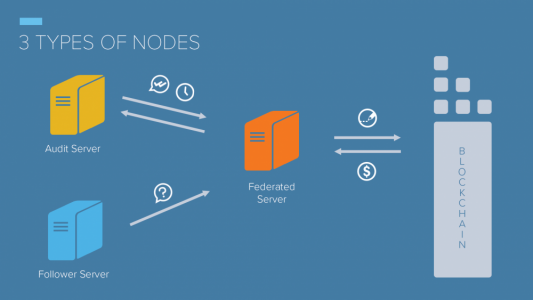Factom is a blockchain-agnostic technology for securing documents of all kinds. This takes blockchain technology beyond the finance or currency role seen in cryptocurrencies, allowing documents such as land deeds, mortgages, and more to be protected.
Securing documents in the blockchain makes these systems inherently honest, and as Factom puts it “honesty is good for business”.
What Does Factom Do?

Factom operates on top of an existing blockchain such as Bitcoin or Ethereum, and uses that to secure data and make it verifiable and auditable. This allows Factom to use the transparency and security of the blockchain without adding large numbers of individual transactions to systems not designed for handling large numbers of individual transactions at high speed and low cost.
What kind of data does Factom handle? Land deeds, film scripts, accountancy records, medical records, smart city data (which can mean almost anything that can happen within a city), mortgages, CCTV records, and more. Anything that an institution and its customers would want to store securely, and without the possibility of it being secretly changed, can be stored in Factom.
In the current world, documents rely on trust between individuals and institutions – trust that is too often lacking or undeserved. Factom’s goal is to automate that trust, so both clients and businesses can know that the documents they’re relying on haven’t been edited without their consent.
The History of Factom
The idea for Factom grew in January 2014, during a conversation between Paul Snow (now CEO) and David Johnston (now Chairman of the Board) about how blockchains could support a form of distributed identity.
In just under six months, that conversation progressed to the first Github commit, and within the first year both the Factom white paper and Version 0.1 were released. The first software tokens (Factoids) were sold in March 2015.
A major part of Factom’s history has been their partnerships with major institutions, such as the government of Honduras (to secure the land deed record and avoid the problem of fraudulent and incorrect land title claims) and the Department of Homeland Security in the US (for securing Internet of Things devices).
How Factom Works
Factom doesn’t write data directly to the Bitcoin blockchain (or any of the alternative blockchains, like Ethereum) as that would be impractical and consume too much of the limited and valuable transactions per minute.
Instead, it writes a hash of data stored in Factom (an ‘anchor’) to the blockchain, creating a record that can be used to check for any edits, and to confirm if there have been unauthorised edits.
In Factom’s whitepaper, it is clear that they can’t provide data verification services – that would have to be carried out by existing authorities (solicitors, courts, managers in charge of due diligence, etc). What Factom can do is record any edit that occurred and prove that the same document at two different times is the same document.

These records are handled by Factom’s Federated Servers, which are what write to the blockchain. These servers are checked by Audit Servers, while the entries to be recorded are sent by Follower Servers.
Factom’s Two Tokens: “Factoids” and “Entry Credits”
Factom is the infrastructure, but of course there are the coins as well.
Factom uses two kinds of tokens:
- Factoids (FCT) are the coins of Factom and tradable for other cryptocurrencies, fiat currencies, etc.
- Entry Credits (EC)
Factoids operate much like BTC or ETH but serve to fund the operation of the Federated Servers. However, to actually use the data securing services of the Factom protocol, you would need Entry Credits, bought using Factoids.
Each Entry Credit allows you to write 1kb of data to the blockchain. The supply of Factoids is controlled because buying an Entry Credit with a Factoid “burns” that Factoid, while the demand for Factoids is kept high because that is the only way to buy Entry Credits.
Factoids have a floating price, determined by the market like any other cryptocurrency, but Entry Credits have a fixed price of $0.001.
When you burn Factoids to receive Entry Credits, you receive an amount of Entry Credits set by Factoid’s market price, not by the number of Factoids you burned. This keeps Entry Credits stable, allowing for budgeting and cost control. At the same time, this allows Factoids to vary in price, making them a valuable commodity beyond their role in the Factom protocol.
Factoids will be provided to the federated servers in exchange for their support for the Factom protocol. They are currently available for purchase through BTC (and some other coins such as ETH) on exchanges like Poloniex, Bit z, and Bittrex.
The Factom Team and Structure
The original core pair behind Factom, Paul Snow and David Johnston, are still part of the leadership team at Factom, alongside Peter Kirby, the President of Factom.
Factom Inc is based in Austin, Texas, while the nonprofit Factom Foundation is based in London. Factom Inc is the business side, building tools for institutions that run on the Factom protocol such as Harmony, and dLoc. Factom Foundation is the open source side, promoting the use of the Factom protocol more generally and supporting it as a public utility.
The Future for Factom
Factom’s newest product is Harmony, a data management tool for the mortgage industry. Harmony brings transparency and trust to a sector where, in the past, even major providers have been caught in fraudulent activity.
Factom expects to continue growing, and has separated its activities into two organisations:
- Factom Inc, producing tools and app for data management in the block chain
- Factom Foundation which pushes the open source side of Factom, offering the Factom protocol for anyone to use.
Factom does more than offer a new currency; it offers a new range uses of the blockchain concept. Hopefully, Factom will fulfill all the hopes that they and their fans in the blockchain community have set out.
To learn more about Factom, visit their website and read their whitepaper. You can also check out their reddit page and follow them on Twitter.

